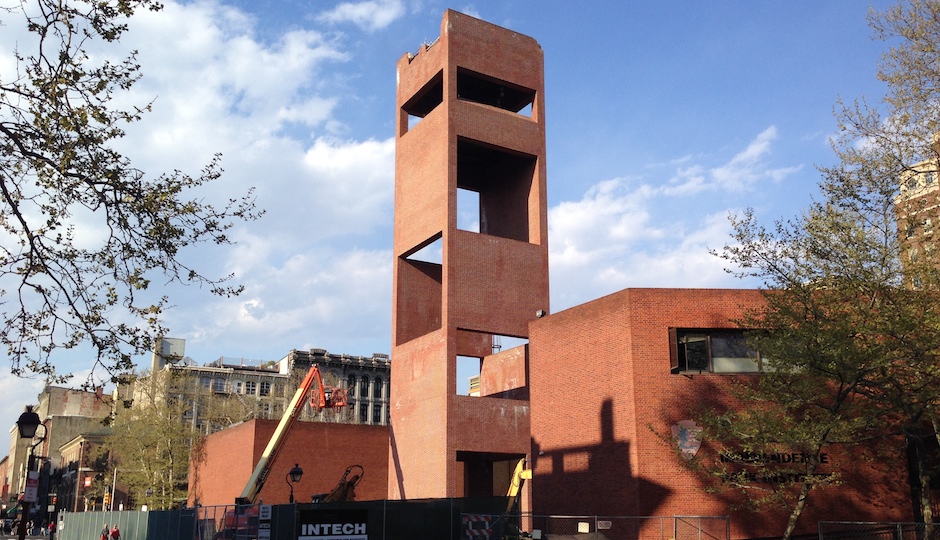Straight Talk With Bicentennial Architect Peter Chermayeff
The old Independence Visitor Center, constructed by the National Park Service for the 1976 Bicentennial celebration, has not been receiving a lot of love in recent years. A replacement on Independence Mall opened in 2001, rendered the old building basically obsolete; and about a decade ago, the Bicentennial bell housed in the center’s bell tower broke and was never repaired. Now the building is being demolished to make room for the planned Museum of the American Revolution, and no one, as far as I can tell, seems to really mind.
The building’s architect, Peter Chermayeff, doesn’t either. “I’m not surprised that the building is being replaced, because I don’t think of it as very strong or a very important piece of contemporary architecture,” he said when informed of the demolition. “I’m not terribly sorry to hear that it’s going.”
Chermayeff, who is still practicing architecture today, co-founded the firm Cambridge Seven Associates in the early 1960s. Initially, he was excited about the Bicentennial project — a “wonderful site in an environment of wonderful historical buildings” — for which he chose to take a modern approach. “To be respectful of history, you don’t imitate it,” he said. He wanted to design a building that would stand apart, be bold, and use new vocabulary.
A particular emphasis for the design was the circulation pattern, to make sure it could handle large numbers of visitors. “The flow was a very important part of the overall experience,” he says, “as was the movement out to the rest of the park.”
And then there was the Liberty Bell, previously housed at Independence Hall, that would go right out in front.
Chermayeff designed a prominent bell tower for the historic treasure — a setting he hoped would be “beautifully simple and elegant, to let it tell its story reticently but powerfully. This Revolution-era artifact would be seen against plain brick, with beautiful light coming from above,” he says. “I worked out a design for suspending the bell by cables so it would be rigidly held to its yoke, which was simply a bar of stainless steel, to allow it to swing.” (In Independence Hall, the bell had been connected to a Victorian-era yoke, an “alien form,” he says.)
Unfortunately, the park’s plan to move the Liberty Bell was derailed. “The advisory committee, led by this man [Arthur Kaufmann], a kind of elderly gentleman of Philadelphia… came to a feeling of its own that it was wrong for the Liberty Bell to be placed in a modern building.”
“The Park Service did not agree with him, but this man was determined, and he lobbied not only his own committee, but he started lobbying people in Washington,” Chermayeff says. “[He got] a Republican leader in the Senate, and others, to bring it to a vote in some kind of way, with a Senate committee or something; got enough members of Congress to agree with the advisory committee’s position and overturn the Park Service’s intention to mount the Liberty Bell in this new tower I was designing.”
Chermayeff was told by park superintendent Hobart G. Cawood that another use would have to be found for the tower. So he called the British embassy and suggested that “Her Majesty’s government” might want to give America a Bicentennial birthday present: a bell made at Whitechapel Bell Foundry — the same foundry that made the Liberty Bell — to hang in the tower. The bell was made and Queen Elizabeth II came and spoke at the Visitor Center dedication on July 6, 1976.
Chermayeff remembers getting some private time with the queen at the dedication.
She asked, “Mr. Chermayeff, how did you do this?”
When he told her about Whitechapel Bell Foundry, she turned to Prince Philip and said, “Philip, why can’t I go there?”
Philip replied, “Well, it’s not been considered a very safe part of the city.”
But the queen apparently insisted. A few years later, when Chermayeff saw Prince Philip in an unrelated setting, the prince confirmed that he had indeed taken her to visit Whitechapel.
Even with a replacement bell, the absence of the Liberty Bell, Chermayeff felt, crippled the Visitor Center.
“Ultimately, I was disappointed because the building needed an artifact at the bottom of that tower to justify the design and the layout. Without it, it seemed rather shallow and cavernous, and too large.”
For a long time the Bicentennial bell was rung twice daily, but last spring, the broken bell was moved to storage.
As for the replacement of the old Visitor Center — the Museum of the American Revolution — Chermayeff was unimpressed by the renderings. “That’s very disappointing,” he said of architect Robert A.M. Stern’s faux-historic design. “I would hope that something much more meaningful and strong and timeless would be done.”
“To me, [Stern] has been a figure of mixed interest,” Chermayeff said. Though he realizes some believe he’s a rare talent, Chermayeff feels Stern’s work is “more connected to fashion and to personal idiosyncratic ideas than it has been to larger values.”
Stern’s proposed design “sounds to me like a retrogression to the advisory committee days when they took the Liberty Bell away,” he said. The irony is that just about a year after that decision was made, the bell had to be moved anyway because of the overwhelming crowds. Since then, it’s been kept outside of Independence Hall; currently, it’s housed in a glassy structure by Bohlin Cywinksi Jackson.



